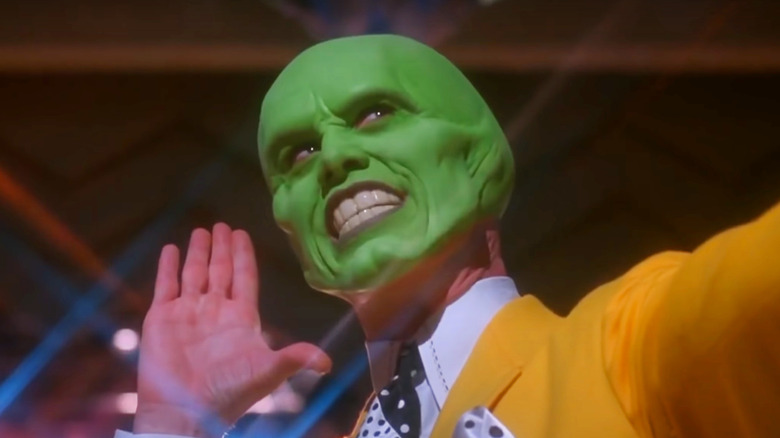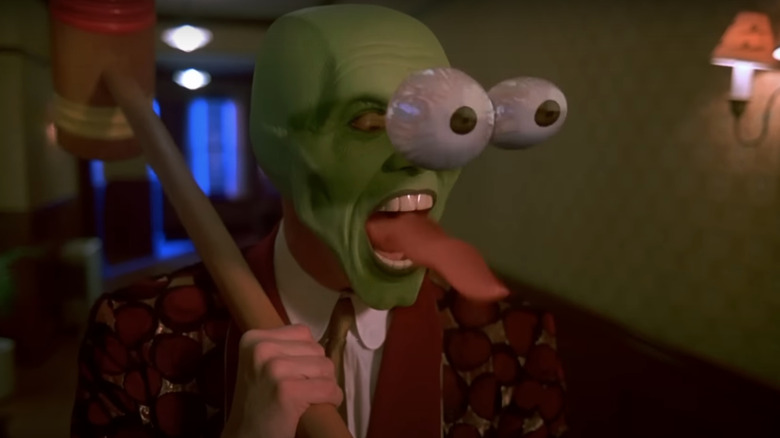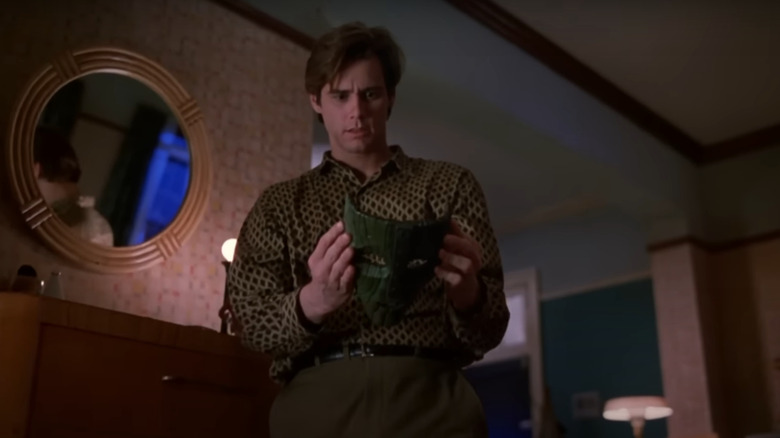How The Mask Managed To Transform Jim Carrey Without Hiding His Unmistakable Face
Everyone knows Jim Carrey's lovably outrageous superhero character in "The Mask." But it might surprise you to learn the original comic book on which the film is based was a hell of a lot more violent. The "Mask" comic featured a homicidal central character who would don the eponymous artifact only to unleash hell on those who'd wronged him by the most violent means possible. It had some of the humor that would eventually make it into the 1994 movie, but otherwise, it was wholly different from its feature film adaptation.
When it did come time to adapt the comic for the big screen, New Line was looking for something different from the source material. The studio responsible for the "Nightmare On Elm Street" series was open to the idea of doing "The Mask" as a comedy horror, but they couldn't get the screenplay right. Thankfully, while flipping through the comics, director Chuck Russell, who had previously directed "A Nightmare on Elm Street 3: Dream Warriors 3," came up with the idea that would finally give the studio what it needed to move ahead: make the film a comedy.
The next thing Russell and co. needed was a comedic actor to play the main part. Enter, Jim Carrey. The relatively unknown Canadian had made an impression with his physical comedy on sketch show "In Living Color" and his larger-than-life presence seemed perfect for "The Mask." But that meant Russell was faced with a challenge: how do you preserve the all-important details of Carrey's famous rubber face in a movie where he's wearing prosthetic facial features half the time? Allow us to explain!
Using Jim Carrey's bone structure was the key
In a making-of documentary for "The Mask," Russell recounts how he and screenwriter Mike Werb took inspiration from animator Tex Avery, fusing his sometimes-grotesque, always-funny style with the movie's themes of people's inner selves coming to the forefront. Carrey's bombastic style was a perfect fit, but Russell still faced the problem of allowing his lead actor to use his "extremely mobile face" to emote while wearing substantial silicon and latex prosthetics.
In Forbes' oral history of "The Mask," the director explained how Steven Williams from famed effects company Industrial Light and Magic and makeup effects artist Greg Cannom helped him deal with the problem:
"They were doing tests right from pre-production to make sure we could do these transformations on Jim without replacing him ... I worked out how to do a design with a lot of very, very small applications with one headpiece off of the boney structures on Jim's face, so I could still get that expressiveness."
Russell and Cannom accentuated Carrey's cheekbones, forehead, and chin, while everything else was "such a thin prosthetic that you got every expression ... that Jim Carrey normally does." The team eventually enhanced certain shots with CGI but the central performance was all captured in-camera.
There's a lot to learn from The Mask's effects
Covering Carrey's face in prosthetics wasn't the only thing about "The Mask" that was risky. This was the most expensive film New Line had made at the time, and neither Carrey nor his co-star Cameron Diaz were established names, though Carrey would see "Ace Ventura: Pet Detective" become a hit months before "The Mask" hit theaters. It also wasn't clear that Russell's background in horror was going to lend itself to a comedy. Happily, it was that very background in horror that helped Russell and his effects team tackle the prosthetics problem. As Producer Bob Engelman said, "Chuck had the right sensibility for 'The Mask' because he understood effects at that point. He had this strong base in horror which is where this project started at."
Ultimately, Russell's appreciation for practical effects seems even more relevant today. His belief that "the actor and the [CGI] optical have to really be working together" recalls the approach of directors such as David Fincher, who are well-known for using digital effects to enhance practical shots rather than relying on computers outright.
As fondly remembered as "The Mask" is, its enduring charm has less to do with nostalgia and more to do with its style, which features strangely more realistic VFX than even the most outlandish effects-driven movies made today. The film belongs to a time when CGI was in its infancy, and as such, it represents a balance between practical and digital effects that's a rarity in the modern age.
With a generation of film-makers who grew up on films like "The Mask" coming to prominence, things seem to slowly be changing in that regard. Denis Villenueve's "Blade Runner 2049" is a great example of retaining a feeling of tangibility while using extensive effects. Meanwhile, "The Mandalorian" used a $5 million dollar Yoda puppet instead of CGI for its tiny Jedi master. Fingers crossed that trend continues long into the, hopefully less CGI-heavy, future.


